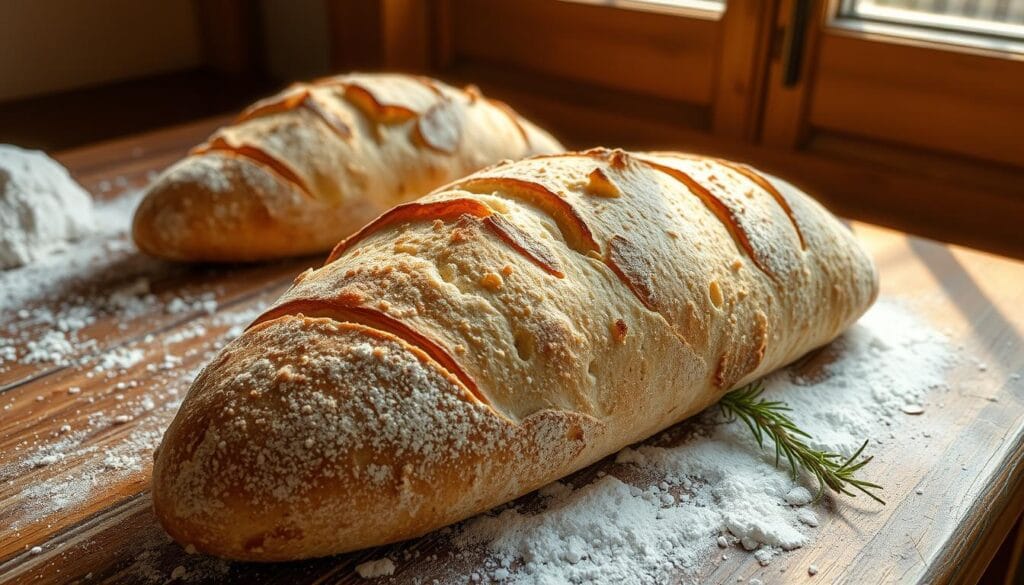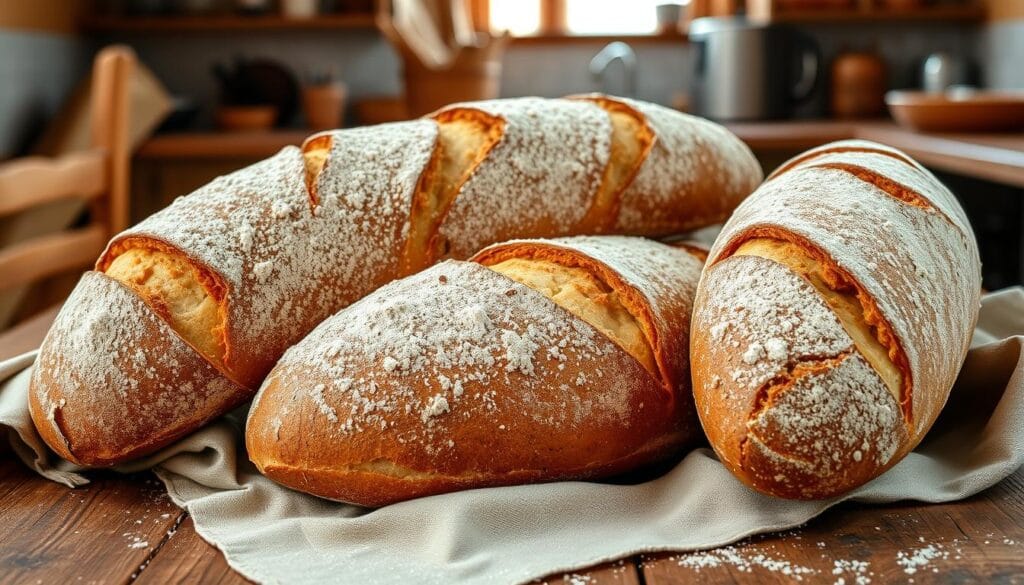Discover Authentic Artisan Italian Bread at Home
The smell of fresh bread in the kitchen brings back happy memories for me. Growing up, I loved watching my Italian grandmother make bread. She kneaded the dough with skill, creating loaves that were both beautiful and full of flavor.
The crust would crackle when we cut into it, revealing soft, pillowy bread inside. The taste was unmatched.
If you’ve ever wanted to make bread like that at home, you’re in luck. You can make authentic Italian bread in your kitchen. Just a few ingredients and some patience are all you need. You’ll soon be baking rustic loaves that feel like they came from a traditional European bakery.
Table of Contents
Understanding Traditional Italian Bread Making
Dive into the world of authentic Italian bread-making. Here, old traditions and artisanal skills blend to create old-world recipes and sourdough baking wonders. The core of this tradition is simple: flour, yeast, water, and salt.
The Art of Lean Dough
Italian breads like ciabatta and focaccia are lean. They have little fat or sugar. This lets the flour, fermentation, and baking shine, creating deep flavors.
Regional Italian Bread Varieties
Italy’s regions have their own handcrafted breads. From Tuscany’s salt-free Pane Toscano to Sicily’s sesame-studded Pane Siciliano, each shows Italy’s baking heritage.
The Role of Time and Temperature
Time and temperature are crucial in Italian bread-making. A no-knead dough ferments slowly, developing rich flavors and a soft texture. Proofing at the right temperature, below 75°F (24°C), ensures the perfect rise.
| Bread Variety | Region | Key Characteristics |
|---|---|---|
| Pane Toscano | Tuscany | Salt-free, crusty, and chewy |
| Pane di Altamura | Puglia | Protected regional product, made with semolina flour |
| Pane Siciliano | Sicily | Features sesame seeds, made with semolina flour |
| Focaccia | Liguria | Versatile, can be topped with various ingredients |
| Pane Cafone | Campania | Rustic bread made with a mixture of wheat and rye flours |
“The secret to authentic Italian bread lies in the simplicity of its ingredients and the patience of its makers.”
Essential Ingredients for Artisan Italian Bread
Making authentic artisan Italian bread at home starts with the right ingredients. You need all-purpose flour or bread flour, warm water, yeast, and salt. Some recipes also include a bit of butter or olive oil for extra flavor.
When baking, precision is crucial. Use a digital scale to measure ingredients accurately. The recipe calls for just a little yeast, about 1/2 teaspoon for 5 cups of flour. This allows the dough to rise slowly, developing its special taste and texture.
| Ingredient | Quantity |
|---|---|
| All-purpose flour or bread flour | 3 1/2 cups (420g) |
| Warm water | 1 1/2 cups (355ml) |
| Instant yeast | 1/2 teaspoon |
| Granulated sugar | 2 teaspoons |
| Salt | 1 1/2 teaspoons |
| Olive oil (optional) | 1 tablespoon |
Choosing the right ingredients and following the recipe carefully will help you make perfect artisan Italian bread. It will taste just like it’s from Italy.
The Magic of No-Knead Technique
Learn how to make rustic loaves and handcrafted breads at home with the no-knead method. This technique uses time to create the perfect dough, skipping the long kneading. You get moist, tasty loaves with a soft, airy texture that will wow everyone.
Stretch and Fold Method
After mixing, the dough gets a series of gentle “stretch and fold” moves. This helps strengthen the dough without hard kneading. You stretch and fold the dough, turning the bowl 90 degrees each time. Do this two or three times to build the dough’s strength.
Overnight Fermentation Benefits
The real magic happens when the dough rests for 12 to 18 hours, often overnight. This time lets the rustic loaves and handcrafted breads develop amazing flavors and textures. The longer rest improves the bread’s smell, texture, and makes it chewy yet tender.
Building Gluten Structure
The no-knead method might seem easy, but it’s all about building gluten. As the dough rests, glutenin and gliadin proteins bond, making the dough strong and elastic. This, along with the stretch and fold, creates a rustic loaf or handcrafted bread with great texture and structure.
“The no-knead method has revolutionized home bread baking, allowing anyone to create professional-quality rustic loaves and handcrafted breads with minimal effort.”
Mastering the Perfect Dough Consistency
Making the perfect homemade bread begins with knowing the right dough consistency. At first, the dough should be sticky and shaggy. This is normal and necessary for developing the gluten and achieving the right texture.
To reach this perfect consistency, you can use a stand mixer or mix by hand. After mixing, let the dough rest for 30-60 minutes. This rest allows the flour to fully hydrate, making the dough easier to work with later.
During the overnight fermentation, the dough becomes looser and more pliable. This extended rise helps the gluten develop, giving the homemade bread its shape. With the right dough, you’ll make perfect artisan Italian bread every time.

“The key to a successful loaf of homemade bread lies in the dough’s consistency. It’s a delicate balance that takes practice to master, but the reward is a beautifully textured, crusty artisan Italian bread.”
Proper Proofing and Rising Techniques
Learning to proof and rise is key for baking Italian breads, like sourdough. The first rise is vital for building the dough’s structure and flavor. It should turn into a loose, bubbly, and jiggly mass.
First Rise Fundamentals
The first rise, or bulk fermentation, lasts 8 to 16 hours, often overnight. This time allows the dough to develop complex flavors. As it rises, the gluten gets stronger, ready for the next step.
Second Proof Indicators
After the first rise, shape the dough for a second proof. The dough should spring back slowly when pressed, leaving a small dent. If it springs back fast, it needs more time. If it doesn’t spring back, it’s over-proofed.
Temperature Control Tips
Keeping the temperature around 75°F (24°C) is key for proofing and rising. Warmer temperatures speed up fermentation, while cooler temperatures slow it down. Bakers use visual and textural checks to see if the dough is ready for baking.
Mastering proofing and rising unlocks the full potential of traditional Italian breads, like sourdough. With patience, detail, and understanding of temperature, you can get the perfect crumb and crust every time.
Creating the Perfect Artisan Italian Bread Crust
A golden-brown crust is key to authentic Italian bread. Mastering baking techniques is essential. Use your Dutch oven and steam to make your loaves look like they came from a wood-fired oven.
Start by heating your Dutch oven to 450°F (232°C). Place your dough in the pan, greased with parchment paper. Cover it and bake for 15 minutes to trap steam and get a crisp crust.
Then, remove the lid and bake for another 20 minutes. This lets the crust get a deep golden color, like in wood-fired ovens.
You can also use a pizza stone for a similar crust. Preheat your oven and stone to the same high temperature. Slide your dough onto the stone. Use a baking dish of hot water on the bottom rack for steam. This makes the crust crackly.
“The perfect crust is the hallmark of authentic rustic loaves. With the right techniques, you can elevate your homemade bread to new heights of artisanal perfection.”
Whether with a Dutch oven or pizza stone, heat and steam are key. With practice, you’ll make rustic loaves that rival Italian bakeries.

Baking Methods and Equipment Essentials
Take your homemade Italian bread to the next level with the right baking methods and tools. Use your wood-fired ovens or traditional bakery to make artisan bread. It’s a magical process.
Dutch Oven Benefits
A Dutch oven is key for baking amazing artisan bread at home. It traps heat and steam like a pro oven. This makes your bread’s crust golden and the inside soft and airy. Preheat it for 30 minutes before adding the dough for the best results.
Temperature and Timing Guidelines
Bake your Italian bread at 460°F (238°C) for the best results. The Dutch oven’s steam-trapping helps create a perfect crust and interior. Bake for about 30 minutes, adjusting as needed for your oven and dough.
Steam Techniques
- For a baking stone or sheet, use a pan of hot water to create steam in the oven.
- Spritz the loaf with water halfway through baking to mimic a pro oven.
- Use parchment paper to transfer the dough easily into the hot oven, making baking stress-free.
| Baking Technique | Temperature | Timing |
|---|---|---|
| Dutch Oven | 460°F (238°C) | Approximately 30 minutes |
| Baking Stone/Sheet with Steam | 460°F (238°C) | Approximately 30 minutes |
Explore the art of wood-fired ovens or traditional bakeries to make incredible Italian bread at home. Mastering the right baking methods and tools will help you achieve a professional-level finish.
Storing and Maintaining Freshness
Keeping your homemade artisan Italian bread fresh is key. The right storage can make your bread last longer and stay tasty. Let your bread cool down completely before you slice or wrap it. This helps the crust and crumb stay in good shape.
For a short time, store your bread in a paper bag at room temperature. This keeps the crust crunchy and prevents it from drying out too much. Breads like sourdough and brioche can stay fresh for up to a week this way. Their special bacterial cultures and extra fat help them last longer.
To store it for longer, wrap the bread tightly in plastic wrap or foil and freeze it. Freezing stops the bread from getting stale by stopping starch granules from changing. To warm it up, just put it in a 350°F oven for 10 minutes, still wrapped. Let it cool down completely before you slice it to avoid a soggy texture.
FAQ
What makes homemade artisan Italian bread superior to store-bought?
What are the key characteristics of traditional Italian bread?
What are the essential ingredients for artisan Italian bread?
How does the no-knead method work for artisan Italian bread?
How do you achieve the perfect dough consistency for artisan Italian bread?
What are the key steps for proper proofing and rising of artisan Italian bread?
How do you achieve the perfect crust on artisan Italian bread?
What equipment is essential for baking artisan Italian bread?
How do you store and maintain the freshness of artisan Italian bread?
Source Links
- Italian Bread – https://preppykitchen.com/italian-bread/
- Best Rustic Italian Bread Recipe (No Knead) – https://www.savoringitaly.com/crusty-no-knead-italian-bread/
- Grandma’s Italian Bread – https://www.365daysofbakingandmore.com/grandmas-italian-bread/
- Italian Bread – https://baranbakery.com/italian-bread/
- What Are Some Interesting Facts About Italian Bread? – https://medium.com/@lynn_26947/what-are-some-interesting-facts-about-italian-bread-b078e8d3e88c
- The Art of Italian Bread Making: Techniques and Recipes – https://www.linkedin.com/pulse/art-italian-bread-making-techniques-recipes-j46tc
- Artisan Italian Bread – https://cookingwithmammac.com/artisan-italian-bread/
- Artisan Bread – https://sugarspunrun.com/artisan-bread/
- Artisan No-knead Bread – https://www.simplysogood.com/artisan-no-knead-bread/
- Miracle No Knead Bread – https://pinchofyum.com/no-knead-bread
- Crusty Artisan Bread Recipe – Once Upon a Chef – https://www.onceuponachef.com/recipes/crusty-artisan-bread.html
- The Secret to Whole Wheat Italian Bread without Additives – https://justmillit.com/whole-wheat-italian-bread-recipe/
- Easy No Knead Overnight Artisan Bread – https://ourbestbites.com/easy-no-knead-overnight-artisan-bread/
- The Ultimate Guide to Shaping Bread Dough | The Perfect Loaf – https://www.theperfectloaf.com/guides/shaping-bread-dough/
- The Ultimate Guide to Proofing Bread Dough | The Perfect Loaf – https://www.theperfectloaf.com/guides/proofing-bread-dough/
- RUSTIC ARTISAN BREAD: NO KNEAD AND SO EASY TO MAKE! – https://citrineliving.com/rustic-artisan-bread/
- No-Knead Italian Bread – https://cookingwithmammac.com/no-knead-italian-bread/
- Stand Mixer Italian Bread – https://thecreeksidecook.com/stand-mixer-italian-bread/
- Everyday Artisan Bread (New Again!) – Harvest & Nourish – https://harvestandnourish.com/recipes/everyday-artisan-bread/
- Ciabatta Bread Recipe – https://www.browneyedbaker.com/ciabatta-bread/
- The Best Way to Store Bread | The Perfect Loaf – https://www.theperfectloaf.com/the-best-way-to-store-bread/
- The Right Way to Store Homemade Bread So It Stays Fresh – https://www.marthastewart.com/how-to-store-homemade-bread-8557885

